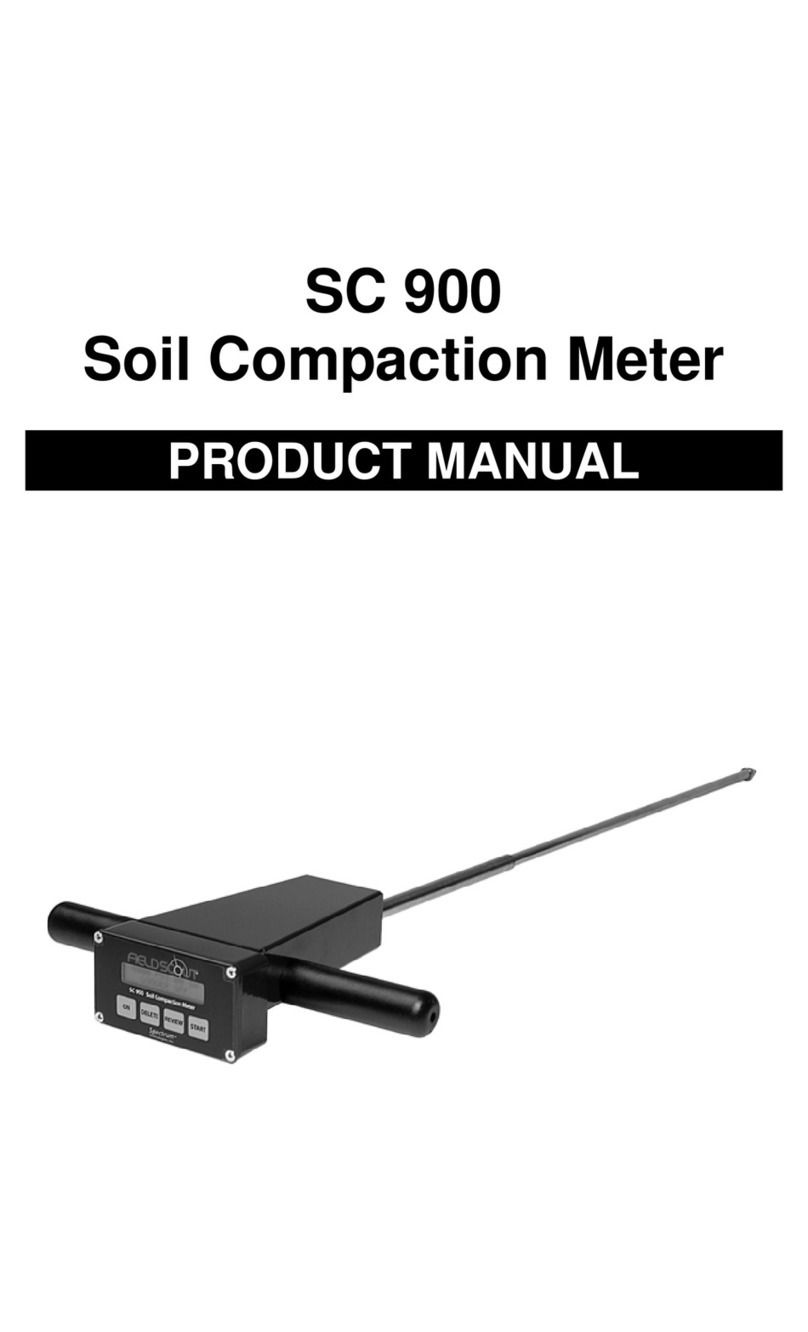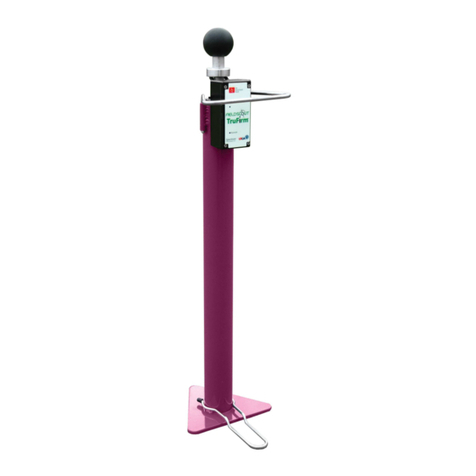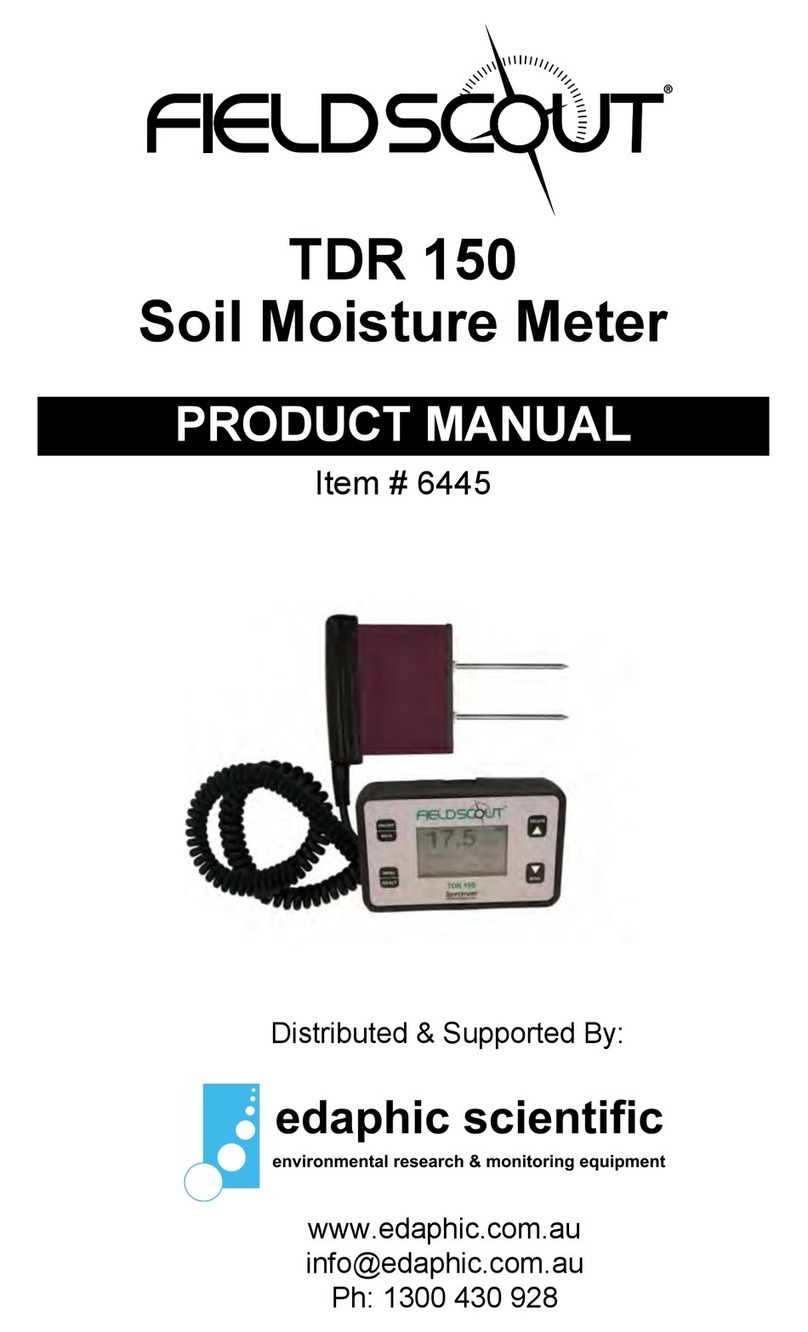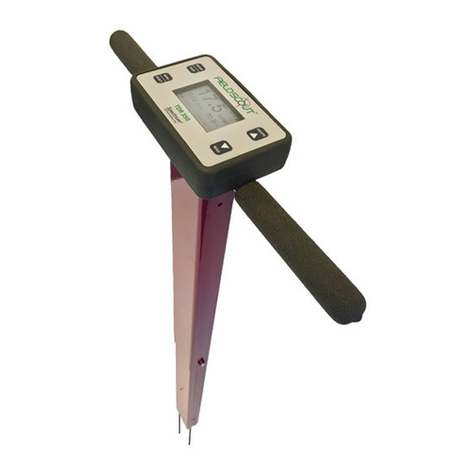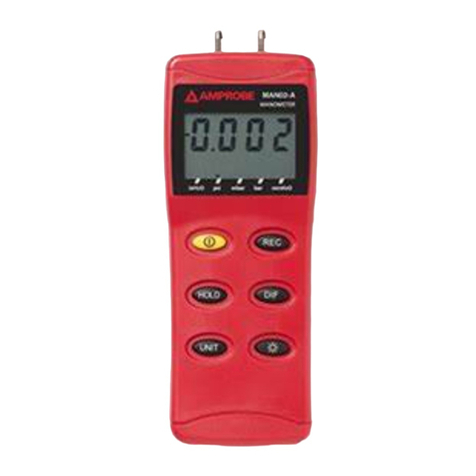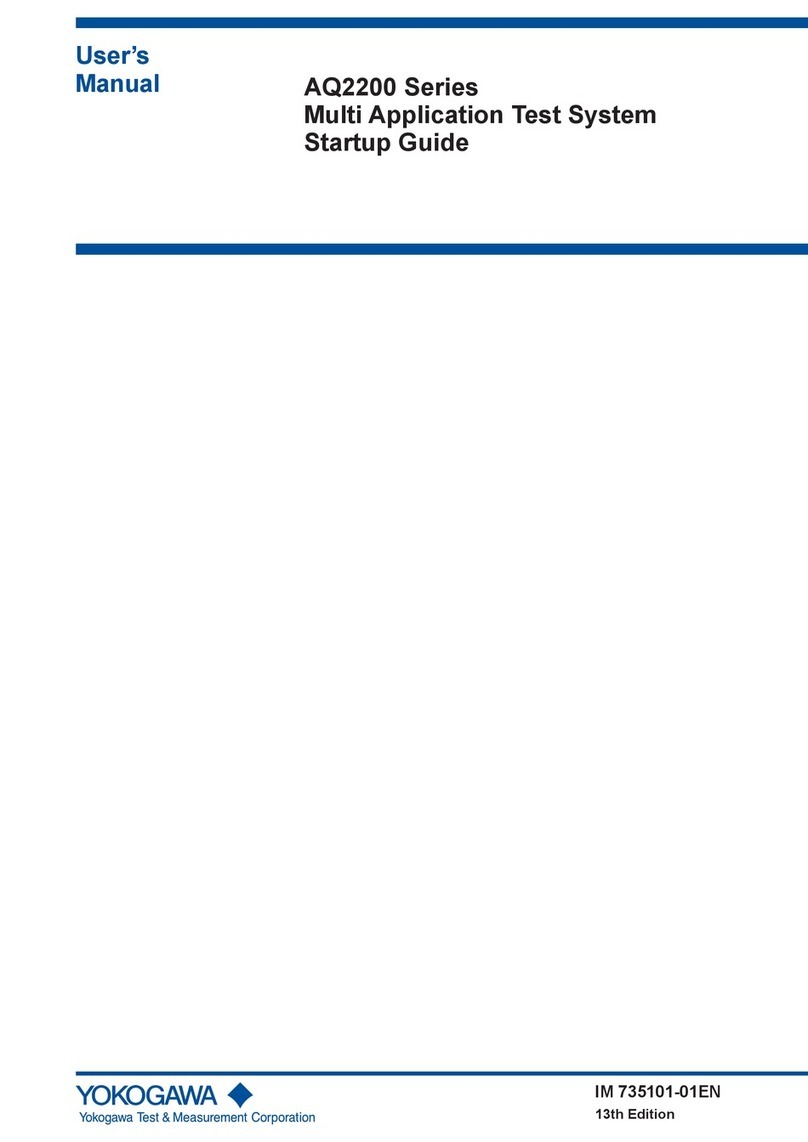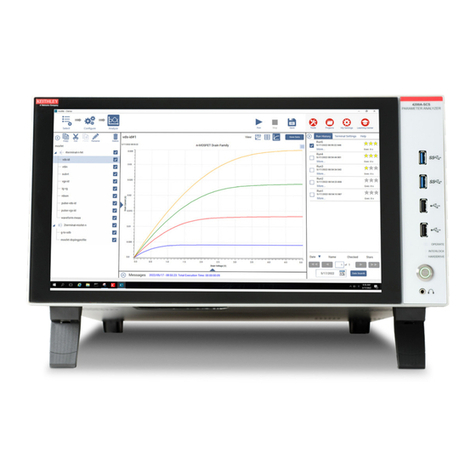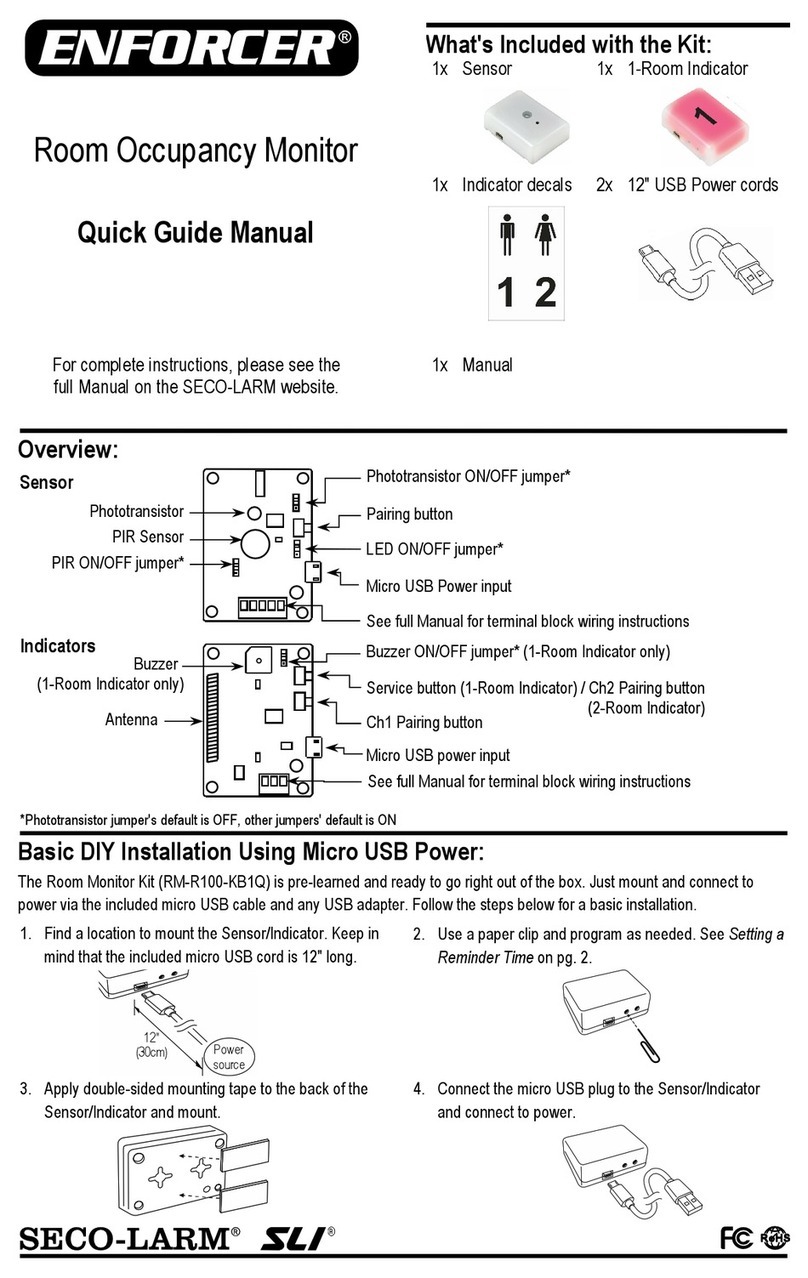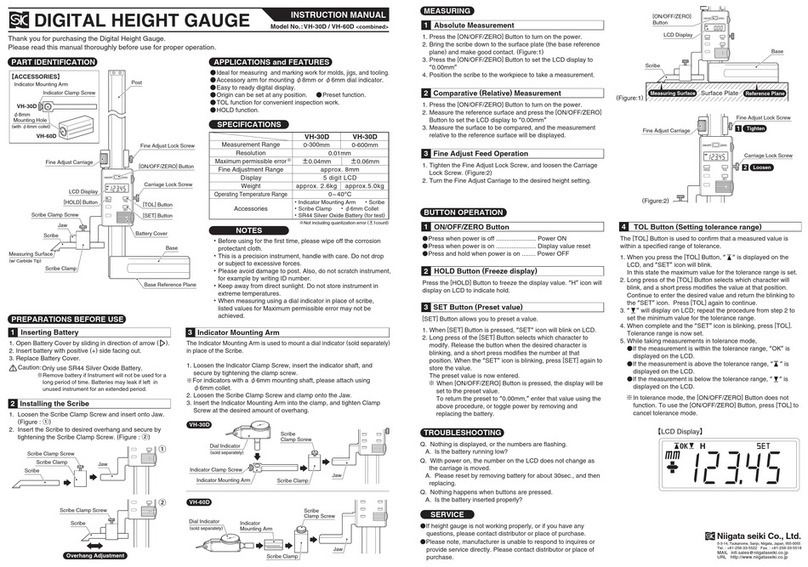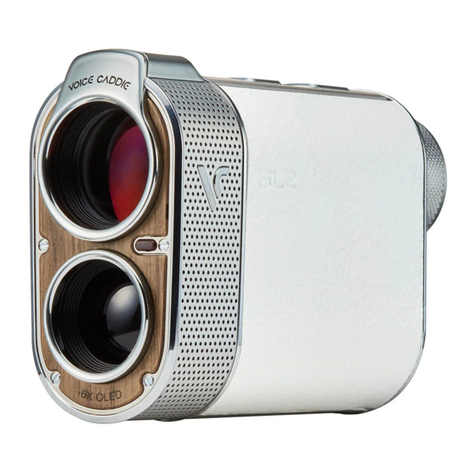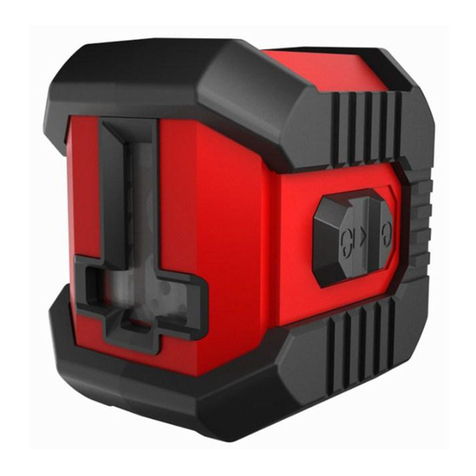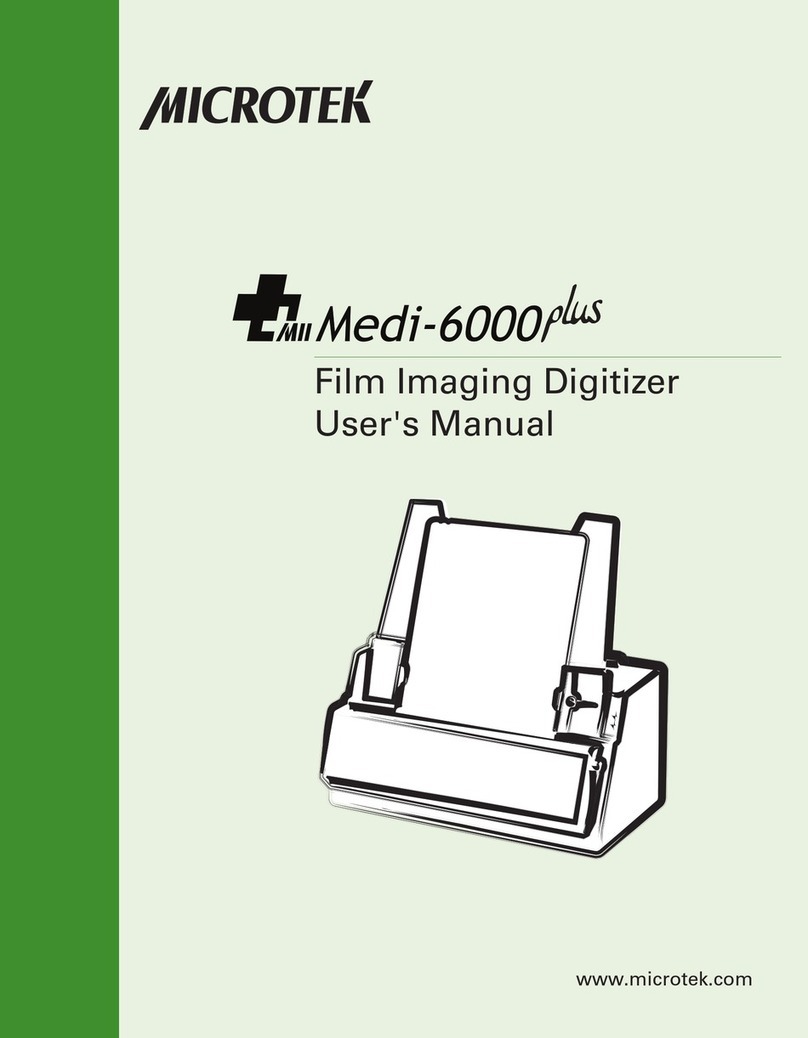Field Scout TDR 100 User manual

TDR 100
Soil Moisture Meter
PRODUCT MANUAL

2
CONTENTS
General Overview 3
Probe Dimensions 3
Meter Operation 4
Volumetric Water Content Mode 6
Relative Water Content Mode 8
Identifying the Correct Com Port 9
Connecting to a PC/Changing Batteries 10
Main Toolbar 11
Meter Settings 12
Meter Calibration 14
Specifications 15
Appendix 1: Soil-Specific Calibration 16
Appendix 2: Checking VWC Readings 18
Appendix 3: Troubleshooting 19

3
Thank you for purchasing the Field ScoutTM TDR Soil
Moisture Meter. This manual describes the features and
operation of the meter.
Soil moisture is a critical and, potentially highly variable
component of the soil environment. Time-domain reflec-
tometry is a proven technology for quickly and accurately
determining volumetric water content (VWC) in soil.
The Field Scout probe allows the user to easily and rapid-
ly take many measurements. The user can quickly transi-
tion between taking VWC readings in standard and high-
clay mode. Through the software, the user can program
relative water content modes for multiple sites.
General overview
1.3”
3.0”
3.1”
Probe Dimensions

4
Meter Operation
Press the READ button to read the probe
and update the screen values. The data
point can be cleared from memory with
the DELETE/CLR AVG button (below).
READ
When the DELETE/CLR AVG but-
ton is pressed and immediately re-
leased, the last data point will be re-
moved from the running average.
Pressing and holding this button will
reset the running average.
Delete
Clr Avg
The ON switch turns the meter on and
off. When the meter is turned on, it will
display the battery status for 3 seconds.
The screen will then display the most
recently used MODE screen
(Volumetric or Relative water content or
measurement period). The data screens for the Water
Content Modes are explained on pages 8 and 10. The Peri-
od mode is used for doing soil-specific calibrations and is
explained on page 14.
ON
Battery at 85%
Firmware V5.0 Stndrd VWC%=27.1
PL=M N008 A=26.5
Sample meter power-up
and data screens Period = 0950 uS
N015
Pressing the MODE button allows the
user to determine the type of measure-
ment that will be taken or select the
length of rods connected to the probe.
MODE

5
Data Measurement Modes
Available measurement options are volumetric water con-
tent (VWC) using the standard or high clay mode (see p.
8), up to two relative water content modes (see p. 10), or
measurement period (in microseconds). Relative water
content options will only appear if they are configured in
the software (see Meter Settings, p. 12). The period meas-
urement is available for users interested in performing soil
-specific calibrations (see Appendix 1).
Changing Rod Length
In order to get accurate volumetric or relative water con-
tent (VWC or RWC) readings, the rod length setting must
be correct. In the VWC modes, the currently selected rod
length appears in the lower left corner of the LCD screen.
The options are Turf (1.5”), Short (3.0”), Medium (4.7”),
and Long (7.9”) rods. Press the MODE button until the
LCD displays the rod length options screen. Pressing the
DELETE/CLR AVG button will allow you to toggle be-
tween the three choices.
Meter Calibration Mode
This mode allows you to calibrate the meter. The calibra-
tion procedure is performed in air and distilled water (see
Meter Calibration, p. 6). Requires firmware v. 6.5 or
greater.
ROD=MED (4.7in)
HIT DEL To Chnge
Rod Length Options Screen
CALIBRATION MODE
HIT READ To Cal
Meter Calibration Screen

6
Volumetric Water
Content Mode
The volumetric water content (VWC) is the ratio of the
volume of water in a given volume of soil to the total soil
volume. At saturation, the volumetric water content
(expressed as a percentage) will equal the percent pore
space of the soil.
The underlying principal of TDR involves measuring the
travel time of an electromagnetic wave along a wave-
guide. The speed of the wave in soil is dependent on the
bulk dielectric permittivity (ε) of the soil matrix. The fact
that water (ε = 80) has a much greater dielectric constant
than air (ε = 1) or soil solids (ε = 3-7) is exploited to de-
termine the VWC of the soil. The VWC measured by
TDR is an average over the length of the waveguide.
Electronics in the TDR 300 generate and sense the return
of a high energy signal that travels down and back,
through the soil, along the waveguide composed of the
two replaceable, stainless steel rods. The sampling vol-
ume is an elliptical cylinder that extends approximately 3
cm out from the rods. The high frequency signal infor-
mation is then converted to volumetric water content.
However, high amounts of clay and high electrical con-
ductivity (EC>2 dS/m) will attenuate the high-frequency
signal and affect the reading displayed by the meter. Very
high organic matter content will similarly affect the VWC
reading.
When taking a measurement, it is important that the rods
be fully inserted into the soil. If not, part of the sampling
volume will be composed of air and the reading will be

7
inaccurately low. For the same reason, the probe should
be inserted with a steady, downward pressure. If the rods
are wiggled into the soil, air pockets can be created adja-
cent to the rods that will result in low readings. The probe
should not be struck with a hammer or other blunt instru-
ment as this can cause damage to the internal electronics.
Also, care should be taken to ensure the rods are inserted
as parallel to one another as possible. This will not have a
large affect on the reading but will decrease the chances
the rods will be bent or broken. Likewise, it is best to
avoid areas with rocks or other material that can cause the
rods to deflect or bend.
Stndrd VWC%=25.5
PL=L N=06 A= 23.4
The TDR meter can be set to one of two VWC modes,
Standard or High Clay. The Standard mode will be appro-
priate for most mineral soils. The High Clay mode will be
more accurate for soils with higher clay contents (>27%).
In VWC mode, the top line of the display shows the VWC
mode and the water content. The bottom line has the fol-
lowing information:
PL: Probe Length (Turf, Short, Medium, or Long rods)
N: Number of readings included in the Average
A: Average of all readings taken since meter was
turned on or DELETE/CLR AVG button was
pressed

8
Relative water
Content Mode
In addition to displaying volumetric water content
(VWC), the meter can also display the relative water content
(RWC) and Water Deficit (see MODE button, p. 5). RWC is
an index value calculated with respect to upper (wet) and low-
er (dry) VWC set points. The set points are configured with
the software (refer to Meter Settings, p. 10). An RWC of 0
indicates the soil is at the dry set point while an RWC of 100
indicates the soil has reached the wet set point. (Example: As-
sume the dry set point is VWC=25% and the wet set point is
VWC=40%. If the meter measured a VWC of 35%, this
would translate to a RWC of 67 because 35% is 2/3 between
25% and 40%.) If the soil’s volumetric water content is out-
side the range of the set points, it is possible to get a negative
RWC or an RWC greater than 100.
If the volumetric water contents for field capacity and
permanent wilting point are the wet and dry set points respec-
tively, the RWC value will be equivalent to Plant Available
Water (PAW). A general rule of thumb is to recommend irri-
gation when the soil has reached 50% of the PAW.
Also included on the first line is the Water Deficit.
The Water Deficit is the amount of rain or irrigation water
necessary to raise the soil water content to the wet set point.
This calculation applies to a soil depth equal to the probe rod
length. The water deficit can be extrapolated further into the
profile if the porosity and water-holding characteristics are
similar to the volume of soil sampled by the probe.
The second line of the LCD gives the Average (A) of
all readings taken, the Number (N) of readings taken and the 5
-symbol name given to this soil type in the Meter Settings
screen (see p. 12).
RWC=25.5 D=3.17in
A=23.4 N=06 Asnte

9
NOTE: The meter does not short-circuit the serial pin.
Therefore, when the Test Port Now button is clicked
while the meter is connected, the “No Connection”
message will be displayed.
The computer
Communications Port
to which the PC-3.5
serial cable is
connected can be
identified by using a
paper clip.
1. Disconnect the serial
cable from the meter.
2. To bring up the Port Selection screen, click on the
Com Port Button, select the com port to be tested and
click the Port Test button. Click the Test Port Now
button. If the message “Connection OK” is displayed,
another device (such as a modem) is probably connected
to that port. If the message “No Connection” is displayed,
this port may be the one connected to your serial cable and
you can proceed to the next step.
3. Place a paperclip on the end of the serial pin so that it
touches both the tip of the pin and the metal area between
the two black rings. Again click on the Test Port Now
button. If the message “Connection OK” now appears,
this is the com port connected to your serial cable.
paper clip
or wire
dentifying the
Correct Com Port

10
Connecting to a PC/
Changing Batteries
The serial port is accessed by removing the face plate of
the digital display. It is through this port that the meter is
connected to a PC.
Connecting to a PC
The TDR meter software comes with a gray PC interface
cable. This cable connects to the 9-pin serial port of your
computer and to the meter’s serial port. The meter’s con-
figuration can be modified by clicking on the Meter Set-
tings button (see Meter Settings, p. 12). The Com Port,
Meter Type, and Clear Meter Settings buttons are ex-
plained in the Main Toolbar section (p. 11).
Changing the batteries
The battery compartment is accessed by removing the me-
ter’s face plate. The meter runs on 4 AAA batteries.
When installing new batteries, note whether the bat-
teries immediately feel hot to the touch. The battery
has been short-circuited and should be replaced.

11
Main Toolbar
Com Port
The gray software cable connects the
meter to the computer data port. Se-
lect the Com Port that is assigned to
the computer data port. See Identify-
ing the Correct Com Port (p. 14) for
instructions on how to determine
which port to select.
Meter Type
Select the TDR option from the list of
available Field Scout meters.
Meter Settings
Click this button to configure the me-
ter and data logger. Refer to “Meter
Settings” (p. 12) for more details.
Download and Clear Memory
These functions are not active with the TDR 100.

12
Meter Settings
With the TDR100, the Meter Settings screen in the Field
Scout software is mainly used to enter the set points for
the Relative Water Content mode. The meter name and
measurement units are also entered here. The fields are
described below.
Meter Name: The name given the meter will be the title
on the first line of the downloaded text file.
Units: When operating the meter in Relative Water Con-
tent mode, the LCD can display the rod length options in
English or metric units. The meter will calculate and dis-
play the water deficit (see Relative Water Content p. 10)
in the same unit system.

13
Relative Water Content Set Points: Up to 2 Relative
Water Content (see p. 10) modes can be programmed into
the meter by entering the wet and dry set points into the
appropriate boxes. From the dropdown menus near the
bottom of the screen, select which VWC calibration
(Standard or High Clay) should be used for each RWC
mode. Each of these modes can be given a descriptive
name of 5 characters. These names can be used to identi-
fy a certain field or soil type.
Finally, for an RWC mode to be available, it must be ena-
bled by checking the Enable Display box. If this box is
not checked, that RWC mode will not appear on the LCD
during meter operation.

14
The meter has internal calibrations for standard and
high-clay soil types. These calibrations will work for a
large number of soils. However, each meter will have a
small difference in how it responds to identical soil
conditions. This is due to sensor drift or variability in
the electronic components used during manufacturing.
Meters with firmware v. 6.5 or greater allow for adjust-
ments to the meter calibration to account for these dif-
ferences. Therefore, if two meters are giving slightly
different readings in the same soil, the output of the
meters can be standardized such that the meters can be
used interchangeably. The calibration procedure is as
follows:
1. Use the MODE button to put meter in Calibration
mode (see p. 5). Hit the READ button
2. Hold the meter so the rods are in the air. Press the
READ button and wait until the meter indicates it is
ready.
3. Immerse the rods completely in distilled or de-
ionized water. The container should have a minimum
diameter of 3 inches. Press the READ button and wait
until the meter indicates it is ready.
The meter will then show that the calibration is com-
plete for that specific rod length. If more than one rod
size is being used, a calibration operation must be done
for each one.
Note: This procedure is different than a soil-specific
calibration (Appendix 1, p. 16) where a unique calibra-
tion curve is generated.
Meter Calibration

15
Measurement
Units
Percent volumetric water content
Resolution
0.1%
Accuracy
±3.0% volumetric water content
with electrical conductivity < 2 dS m
–1
Range
0% to saturation (Saturation is typical-
ly around 50% volumetric water.)
Power
4 AAA alkaline batteries
Approximately 12 month life
Display 16 character, 2 line LCD
Weight 1.5 lbs. (0.68 kg)
Probe Head
Dimensions 3.1” x 3” x 1”
(7.8cm x 7.5cm x 2.5cm)
Rod Dimensions Length : 1.5” (3.8cm), 3” (7.6cm),
4.7” (12cm) or 7.9” (20cm)
Diameter: 0.2” (0.5cm)
Spacing: 1.3” (3.3cm)
Specifications
The meter’s LCD screen will display the data in one of
three modes (see Meter Operation p. 4):
1. Volumetric water content - in Standard or High Clay
mode (see p. 8).
2.
Relative water content - up to 2 RWC modes can be
established (see p. 10).
3.
Measurement period - in microseconds

16
For maximum accuracy, you
may choose to perform a soil
-specific calibration rather
than use either of the internal (Standard or High Clay) soil
calibrations coded into the TDR meter’s firmware. In
these cases, an independent soil moisture content meas-
urement is required. A relation can then be developed that
relates the meter’s period reading (see MODE button, pp.
4-5) to actual volumetric water content (VWC). This is
most easily accomplished by doing a regression of one set
of data against another.
VWC data can be obtained with a device such as a neutron
probe, by measuring the weight of a saturated soil column
of known volume as it is gradually dried, or by gradually
wetting a known volume soil with the addition of known
increments of water. In most cases, however, the calibra-
tion will be done with gravimetric sampling. This proce-
dure is briefly described below.
In the field, establish a number of sites to sample. Each
site should be wetted to a different soil moisture content
by adding varying amounts of water. At each site a Field
Scout TDR reading is taken followed by the extraction of
a known volume of soil. Ideally, this would be an undis-
turbed soil core. The wet weight of this soil must be de-
termined. If the soil cannot be weighed immediately, it
should be stored in a plastic bag to reduce evaporation.
The soil is then oven-dried (105o C for 48 hours is a com-
mon requirement) and weighed again. The volumetric
water content is calculated as follows:
Appendix 1
Soil-Specific
Calibration
Period = 0950 uS
N015

17
VWC = 100*(Mwet - Mdry)/(ρw*Vtot)
Where:
Mwet, Mdry = mass (g) of wet and dry soil respectively
Vtot = total soil volume (ml)
ρw= density of water (1g/ml)
An alternate, but equivalent, calculation can be obtained
from the gravimetric water content and soil bulk density.
VWC = GWC *(ρb/ρw)
Where GWC is the gravimetric water content and ρbis the
bulk density:
GWC = 100*(Mwet - Mdry)/Mdry
ρb= Mdry/Vtot
The final step is to plot the calculated the measured period
values with the readings obtained from Field Scout TDR
meter. Regression analysis can then be performed on this
data to develop an equation to convert from period to
VWC.

18
Rod Length Water
8 inches (20 cm) 60 - 65%
4.8 inches (12 cm) 70 - 75%
3 inches (7.5 cm) 75 - 80%
1.5 inches (3.8 cm) 65 - 70%
Note: The meter does not read 100% in water because the soil moisture
calibration equations were created to be most accurate in the volumetric
water contents typically found in mineral soils.
Appendix 2
Checking VWC Readings
There are two tests that can be performed to check if the meter is operat-
ing properly.
Test 1 (No rods): Disconnect the rods from the probe block. Press the
MODE button until the LCD is displaying the Period. With no rods con-
nected, the meter should read 1920 ± 30.
Test 2 (Rods attached): Readings can be taken in three standard environ-
ments; air, distilled water, and playground sand saturated with distilled
water. It is important that any troubleshooting be done with distilled wa-
ter. Readings taken in tap water can differ greatly from the expected re-
sults observed in distilled water. When readings are taken in water and
saturated sand, the container should have a diameter of, at least, 3 inches
(7.5cm) and should be tall enough so the rods can be completely im-
mersed or inserted.
Readings should be taken with the meter in "Stndrd VWC" mode. Be sure
that the correct rod length is selected. The meter should read VWC=0% in
air. In saturated sand, it should read between 35% and 45%. The table
below shows the approximate ranges of volumetric water content that are
expected for the different rod lengths in distilled water.

19
Appendix 3
Troubleshooting
1. I am getting the “VWC%=ERR!” message.
This message appears for two reasons.
1. If the meter is set to read 1.5” (TURF) rods while in HiClay
mode. There is no high clay calibration for the rod length op-
tion. Change the rod length or switch to Standard calibration
mode.
2. The probe block is damaged. A replacement probe (Item
6440FSS) can be purchased from Spectrum Technologies.
2. I am getting VWC values near 0% for all measurements,
even in very wet soil.
Most likely a circuit component in the display is damaged and
must be repaired. Contact Spectrum Technologies or your dis-
tributor to obtain a Return Goods Authorization (RGA) num-
ber.
3. Unable to bring up the Meter Settings screen.
Generally, this indicates that the PC is not able to communicate
with the meter. Check the following:
- The interface cable is securely connected to both the PC and
the meter
- The meter has fresh batteries
- The meter is off
- The correct COM port is selected (see p. 9)
- The Meter Type is set to the TDR family (see p. 11)
Table of contents
Other Field Scout Measuring Instrument manuals
Popular Measuring Instrument manuals by other brands
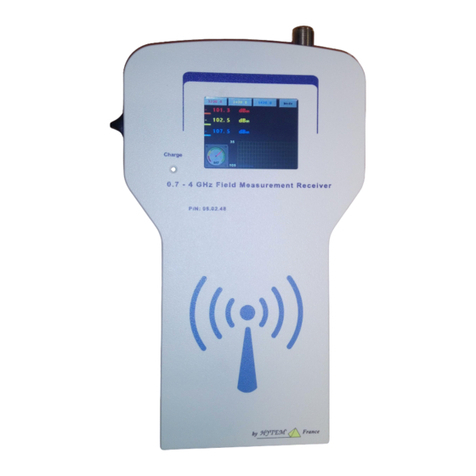
HYTEM
HYTEM 08-02-48 Product specifications and user's guide
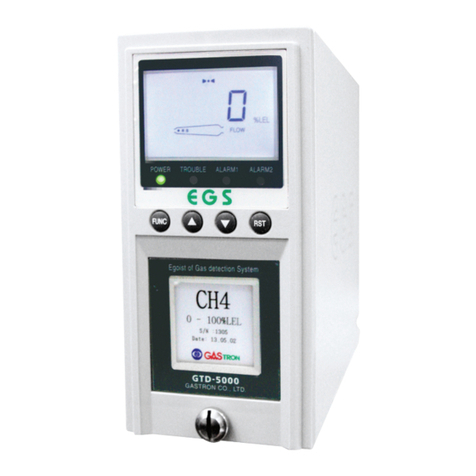
GASTRON
GASTRON GTD-5000 instruction manual
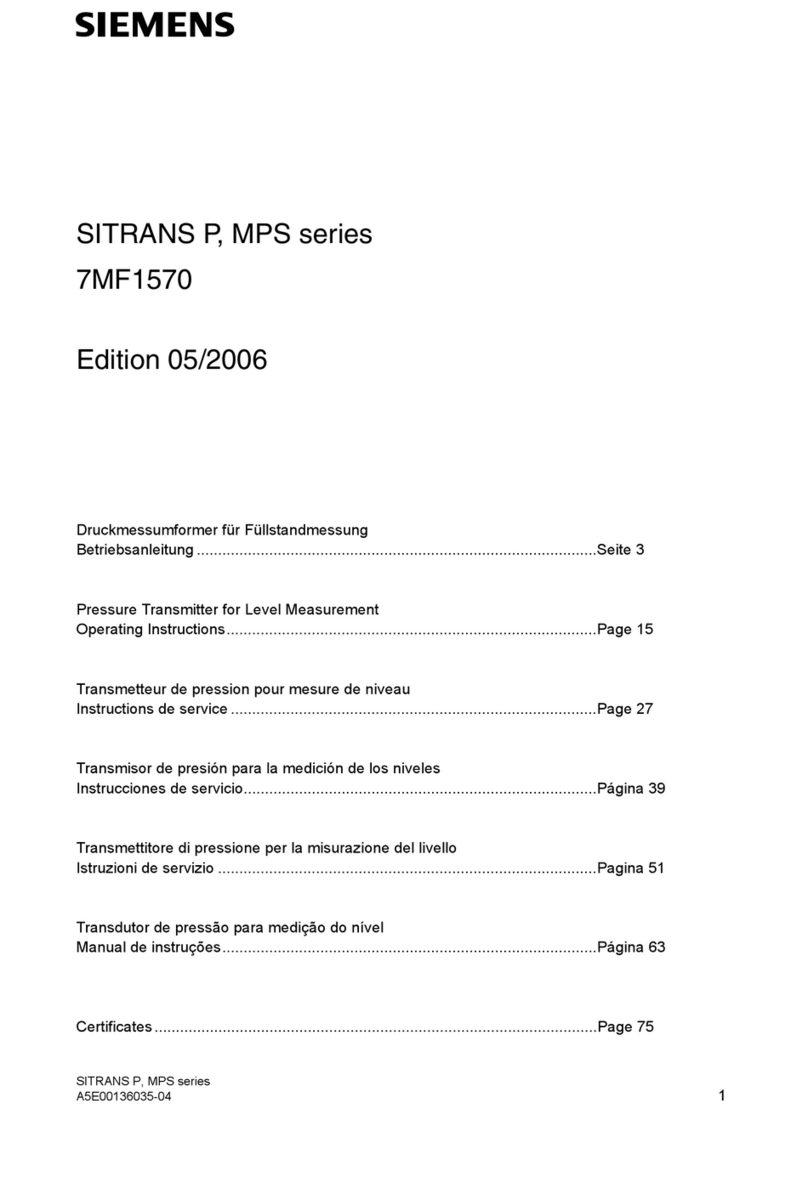
Siemens
Siemens SITRANS 7MF1570 operating instructions

Micronics
Micronics U1000-HM user manual
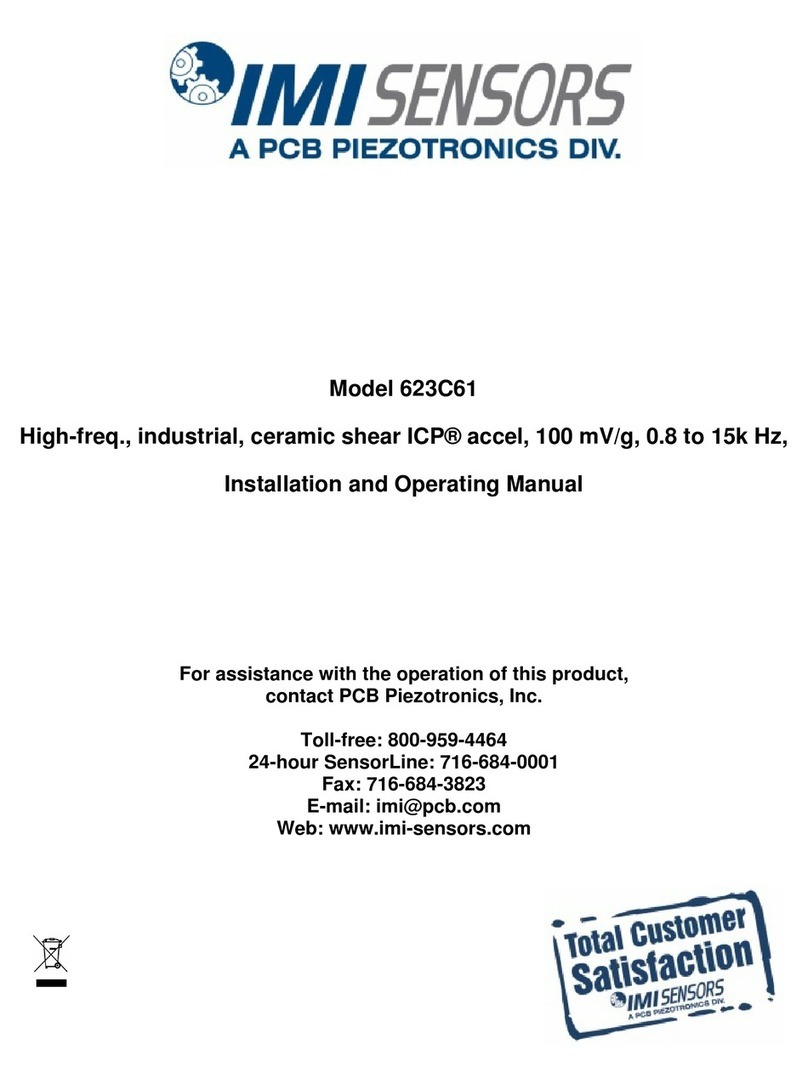
PCB Piezotronics
PCB Piezotronics IMI SENSORS 623C61 Installation and operating manual

PCE Instruments
PCE Instruments PCE-830+PCE-6801 user manual
